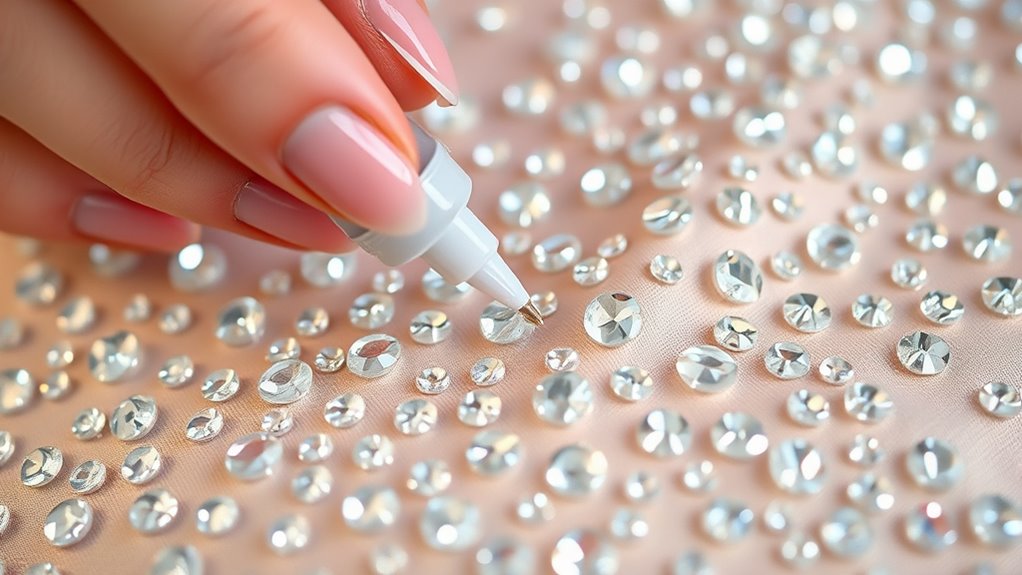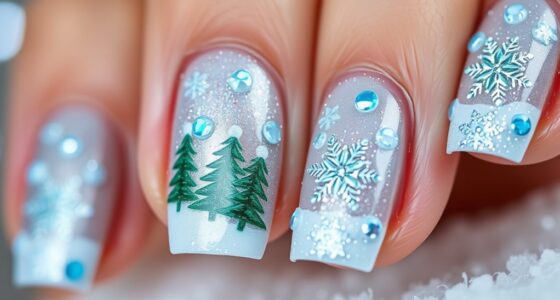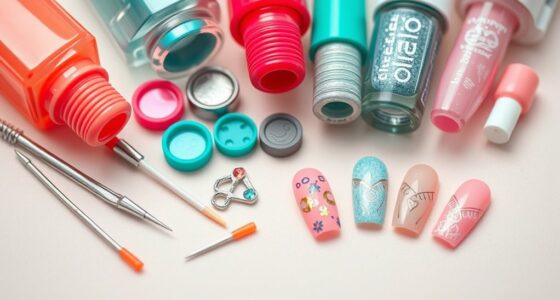To guarantee rhinestones stay on, start by choosing the right adhesive based on your surface—like craft glue for fabric or jewelry adhesive for metal. Apply a thin, even layer of clear nail polish or resin over the rhinestones to seal them securely. Allow ample drying time before handling or exposing to moisture. For long-lasting results, proper surface prep and gentle application matter. Keep going to discover expert tips for durable, professional sealing.
Key Takeaways
- Ensure rhinestones are securely attached with a compatible adhesive before sealing.
- Choose a clear, durable sealant like resin, epoxy, or quick-dry nail polish for long-lasting results.
- Apply thin, even coats of sealant with a brush or applicator to prevent gaps and bubbles.
- Allow sufficient drying and curing time to fully set the sealant for maximum durability.
- Regularly check and re-seal worn or loose rhinestones to maintain their hold over time.
Choosing the Right Adhesive for Rhinestone Sealing

Choosing the right adhesive is vital to guaranteeing your rhinestones stay sealed and secure. There are various types of adhesives to consider, such as craft glue, super glue, or specialized jewelry adhesives. Your choice depends on the surface you’re working with and the durability you need. Before applying any adhesive, proper surface preparation is essential. Clean your surface thoroughly to remove oils, dirt, or residue, which can prevent proper adhesion. If you’re working on fabric, make sure it’s dry and free of loose fibers. For hard surfaces like glass or metal, wiping with alcohol helps create a clean, sticky-free surface. Additionally, understanding the adhesive compatibility of your chosen glue with different materials ensures lasting results. Selecting the correct adhesive and preparing your surface properly guarantees your rhinestones will stay in place longer and look professional. Using a proper curing time allows the adhesive to set fully, ensuring maximum durability and adhesion strength. Incorporating appropriate application techniques can also improve the overall bonding quality, making your rhinestone sealing more effective. Moreover, considering the adhesive’s flexibility can be important for surfaces that undergo movement or stress, preventing the rhinestones from loosening over time.
Applying Clear Nail Polish as a Sealant

Start by selecting a clear nail polish that’s free of glitter or color to guarantee a smooth seal. When applying, use thin, even coats to prevent smudges or bubbles. Finally, give the polish enough time to dry completely before handling your rhinestone-adorned item. For the best results, ensure your application technique is precise to keep the rhinestones securely in place.
Choosing the Right Polish
Applying a clear nail polish as a sealant is a simple yet effective way to protect your rhinestones and keep them secure. When choosing the right polish, consider your rhinestone styles—smaller, delicate designs may need a gentler coat, while larger, bolder pieces can handle a thicker layer. It’s also important to match the polish with your adhesive type; some adhesives might react differently to certain nail polishes. Look for a high-quality, quick-drying clear nail polish free from harsh chemicals to avoid damaging your rhinestones or backing. Testing the polish on a small area first helps ensure compatibility. By selecting the right polish, you’ll enhance durability without compromising the appearance of your rhinestones. Proper sealing can also prevent issues like toilet clogs caused by debris or improper disposal practices. Incorporating proper sealing techniques can further improve the longevity of your rhinestones and reduce the need for frequent reapplication.
Applying Even Coats
Once you’ve selected the right clear nail polish, the next step is to apply it evenly over your rhinestones. Using smooth, gentle strokes helps guarantee consistent coverage, which is vital for maintaining adhesive strength. Focus on creating a thin, uniform layer that follows the surface texture of your rhinestones and surrounding area. Avoid applying too much polish at once, as thick coats can lead to uneven sealing and reduce the overall durability. Take your time to spread the polish evenly, making sure every rhinestone is covered without excess pooling. This careful application helps build a secure seal, protecting the rhinestones and ensuring they stay in place longer. Proper even coats are essential for a professional-looking finish and long-lasting adhesion. Additionally, understanding the gadget breakdowns can inspire innovative sealing techniques for delicate embellishments. For example, a proper application technique can significantly influence the seal’s effectiveness and longevity. Being mindful of consistent messaging in your application process can also contribute to achieving a uniform, durable finish. Applying a water-resistant sealant can further enhance the durability of your rhinestone setting, especially if the item will be exposed to moisture or frequent handling.
Allowing Proper Drying
After you’ve applied the clear nail polish, it’s crucial to let it dry completely before handling your rhinestones further. Proper drying ensures the sealant adheres fully and prevents smudging or lifting. Use a heat setting on a hairdryer, set to low, to speed up the drying process if needed, but avoid overheating, which can damage the rhinestones or the adhesive. When selecting an adhesive, verify it’s compatible with nail polish and designed for long-lasting bonds. Allow ample time—at least 10-15 minutes—for the polish to dry thoroughly. Rushing this step can weaken the seal and cause rhinestones to loosen. Patience during drying guarantees a durable, professional finish that keeps your rhinestones securely in place. Additionally, understanding how glycolic acid benefits skin can help in choosing the right skincare routine to maintain healthy, radiant skin around your rhinestone application area. Moreover, ensuring proper sealing can help prevent airborne pollutants from affecting your rhinestones and adhesive over time. Incorporating proper drying techniques can also help prevent moisture buildup that might compromise the adhesive’s effectiveness.
Using Fabric Glue for Long-Lasting Hold

To guarantee your rhinestones stay securely in place, using fabric glue is an effective method. Choose a glue with strong fabric bond and high adhesive strength to ensure durability. Apply a small amount of glue directly onto the back of each rhinestone or onto the fabric where you’ll place them. Be careful not to use too much, as excess glue can seep out and create a mess. Press the rhinestones firmly into position and hold for a few seconds to allow the adhesive to set. Allow the glue to dry completely before wearing or washing the item. Using fabric glue with excellent adhesive strength ensures your rhinestones remain attached through regular wear and washing, giving you a long-lasting, professional-looking finish. Additionally, selecting the right type of glue can help prevent issues such as detachment during washing, and choosing a high-quality adhesive can further enhance the durability of your design, ensuring your rhinestones stay in place over time. To improve longevity, consider proper surface preparation by cleaning the fabric surface thoroughly before application, which helps the adhesive bond more effectively and prevent peeling or lifting.
Sealing Rhinestones With Resin or Epoxy

Sealing rhinestones with resin or epoxy provides a durable, glossy layer that protects your embellishments from dirt, moisture, and everyday wear. This method creates a strong seal that keeps rhinestones securely in place, reducing the risk of falling off. Before sealing, verify your rhinestones are clean—rhinestone cleaning helps remove oils, dust, and old adhesive residues, which can interfere with adhesion. If you notice adhesive buildup, carefully remove it to ensure a smooth finish. Once the surface is clean and dry, apply the resin or epoxy evenly over the rhinestones using a brush or applicator. This coating not only enhances shine but also locks in the rhinestones, preventing loosening over time. Proper sealing ensures your embellishments stay intact and looking beautiful for longer. Additionally, understanding proper application techniques can help achieve a more even and professional finish. Incorporating proper curing methods is essential for a long-lasting seal, ensuring the resin or epoxy hardens correctly and provides maximum protection. Being aware of AI safety measures can also help in choosing the right products and techniques, ensuring a safe and effective sealing process.
Tips for Properly Using Spray Sealants

When using spray sealants on rhinestones, you want to pick the right type for your project. Make sure to apply thin, even coats and give each layer enough time to dry completely. Following these tips helps achieve a durable, professional-looking finish.
Choose Suitable Sealant Type
Choosing the right sealant type is essential for guaranteeing your rhinestones stay securely in place and maintain their shine. Different rhinestone types, such as glass, acrylic, or resin, may require specific sealant compatibility to avoid damage or dulling. Check the manufacturer’s recommendations to identify which spray sealants work best with your rhinestones. For example, some sealants are designed specifically for delicate or reflective surfaces, providing a clear, protective layer without dulling the sparkle. Avoid using incompatible sealants that might cause discoloration or weaken the adhesive. Selecting a sealant formulated for your rhinestone type ensures a long-lasting hold and preserves their appearance, giving you a professional and durable finish.
Apply in Thin Coats
Ever wonder why your sealant might look uneven or cause drips? Applying in thin coats is key to a smooth, professional finish. To do this effectively:
- Hold the spray can about 6-8 inches from your surface to prevent excess application.
- Spray in light, even passes, avoiding heavy layers that can cause drips or uneven coverage.
- If you notice glitter removal or adhesive lifting, let the sealant dry slightly before adding another thin coat.
- Always clean your surface thoroughly before sealing to prevent uneven spots or the need for adhesive removal later.
Allow Proper Drying Time
To guarantee your sealant provides lasting protection and a flawless finish, it’s essential to allow adequate drying time between coats and after the final application. The drying environment plays a critical role in the curing process; ensure you work in a well-ventilated, dust-free space with stable temperature and humidity. Rushing the drying process can cause smudges, uneven coverage, or sealant failure. Follow the manufacturer’s recommended drying times carefully, and avoid touching or moving the rhinestones during this period. Patience ensures the sealant fully cures, creating a durable barrier that keeps rhinestones securely in place. Proper drying not only enhances adhesion but also ensures your finished project looks smooth, professional, and long-lasting.
How to Seal Rhinestones on Different Materials

Sealing rhinestones requires different approaches depending on the material you’re working with, as each surface interacts uniquely with sealants. Your choice depends on rhinestone styles and material compatibility.
- For fabric, opt for a flexible sealant that moves with the material, preventing peeling.
- On plastic or acrylic surfaces, use a quick-drying, clear sealant to avoid cloudiness.
- When working with metal, select an adhesive-based sealant that bonds well without corroding.
- For glass or smooth surfaces, apply a thin coat of sealant carefully to prevent smudging or uneven coverage.
Always consider the material’s texture and flexibility to ensure your rhinestones stay secure without damaging the surface. Proper selection guarantees durability and a professional finish.
Ensuring Even Coverage and Drying Time

Achieving even coverage and proper drying time is key to a professional-looking seal. To do this, choose from a variety of color options in your sealant to match or contrast your design. Use steady, sweeping motions when applying the sealant to avoid streaks or uneven spots. Incorporate effective design techniques, like applying thin layers and allowing each to dry completely before adding more, to ensure a smooth finish. Keep your workspace well-ventilated to speed up drying and prevent smudges. Be patient—rushing the process can cause bubbles or gaps that ruin your work. By paying close attention to how you apply the sealant and managing drying time properly, you’ll achieve a flawless, durable finish that keeps your rhinestones securely in place.
Maintenance and Re-Sealing for Extended Durability

Regular maintenance is essential to keep your rhinestone seals looking their best and to extend their lifespan. Over time, you may need to perform rhinestone removal or touch up sealed areas to maintain adhesive longevity. To do this effectively:
Regular maintenance keeps rhinestone seals shiny and long-lasting.
- Check for loose or dull rhinestones regularly.
- Gently clean the sealed surface with a soft cloth to remove dirt and debris.
- Re-apply a thin layer of sealant where needed, focusing on edges or worn spots.
- Allow adequate drying time before wearing or exposing the item to moisture.
Re-sealing prevents adhesive deterioration and keeps rhinestones securely in place. Proper maintenance ensures your rhinestone sealing remains durable, saving you from frequent replacements and preserving your design’s shine.
Frequently Asked Questions
Can Sealing Rhinestones Damage Their Shine or Sparkle?
Sealing rhinestones can sometimes dull their shine if you use the wrong sealing techniques or too much rhinestone adhesive. If you apply a thick layer or harsh sealants, it might obscure the sparkle. To keep their brilliance, use a clear, gentle sealant designed for rhinestones and sparingly apply it. Proper sealing techniques guarantee your rhinestones stay shiny and secure without losing their sparkle.
How Often Should I Reseal Rhinestones for Longevity?
Think of sealing rhinestones like watering a delicate plant—you can’t do it too often or they’ll drown. For longevity, you should reseal every 2-3 weeks, depending on sealant compatibility and wear. Regular sealing helps maintain their sparkle and prevents damage. Keep an eye on how well your rhinestones are holding up, and adjust sealing frequency accordingly to keep them shining bright without compromising their shine or sparkle.
Are There Any Materials That Cannot Be Sealed Effectively?
When considering sealing rhinestones, you should be aware of material limitations and incompatible adhesives that can affect effectiveness. Some materials, like fabric or certain plastics, may not bond well or may be damaged by sealants. Avoid using sealants on surfaces that don’t adhere properly or could be compromised, as this can lead to the rhinestones falling off or the material degrading. Always check compatibility before sealing to guarantee long-lasting results.
Is It Safe to Use Household Products as Rhinestone Sealants?
Ever wondered if household products are safe for your dazzling rhinestones? It’s tempting to grab DIY hacks from your craft supplies, but beware—many household items aren’t designed for sealing rhinestones and could damage your work. While some may seem safe, they might cause discoloration or loosen the stones. Stick to recommended sealants for lasting sparkle, and avoid risking your craft’s shine with untested household solutions.
Will Sealing Rhinestones Affect Their Flexibility or Movement?
Sealing rhinestones can affect their flexibility or movement if you use a sealant that isn’t compatible with the rhinestone adhesion. You might notice stiffness or cracking if the sealant isn’t designed for flexible surfaces. To avoid this, choose a sealant compatible with your rhinestones and guarantee it’s flexible enough to allow movement. Proper application helps maintain both the rhinestones’ adhesion and their natural flexibility.
Conclusion
Now that you know all the secrets to sealing rhinestones, your creations will last longer than you ever imagined—defying time, weather, and even the most stubborn spills! With the right sealant, your sparkling designs will stay flawless and fabulous forever. So go ahead, seal away, and watch your rhinestones stay glued in place through storms, dances, and adventures, turning your craft into an unstoppable, shimmering masterpiece that refuses to budge!









